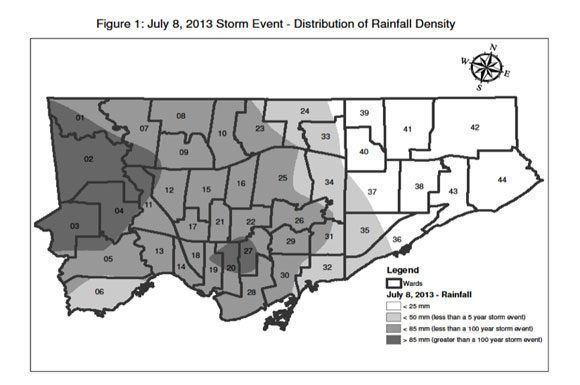Toronto’s record-breaking summer rainstorm — the most expensive natural disaster in Ontario history, according to the Insurance Bureau of Canada (IBC) — left Scarborough relatively unscathed.
The insured cost of the July 8 storm was about $850 million in the GTA based on data the IBC received from Property Claims Services, an authority on insured property losses.
The storm brought with it record rainfall of almost 140 millimetres in just a few hours that “led to a power outage affecting at least 300,000 residents in Canada’s largest city, shut down subways, and left approximately 1,400 passengers stranded for hours on a commuter train filled with water”, the IBC said in a media release.
Toronto Water received over 4,700 calls regarding basement flooding, but only 50 came in from Scarborough, said Ted Bowering, director of water infrastructure management for Toronto Water.
“In Scarborough in fact the storm wasn’t all that intense. It was kind of like a normal summer thunderstorm,” he said. “So the impact was not that great at all.”
The total cost represents the damage to homes and vehicles in the GTA, said Pete Karageorgos, manager of consumer and industry relations for the IBC, which does “not have a breakdown by municipality or area.”
Toronto Water conducts environmental assessments that include studying the whole sewer and storm drain system to identify areas that need to be changed or upgraded through the capital budget process, Bowering said.
When Toronto Water was asked by city council for a report on what it planned to do following the storm on July 8, Bowering said his department recommended studying the entire city rather than the 34 previously identified basement flooding study areas.
“Our earlier program was that parts of the city are more at risk than others,” Bowering said. “What we found out was that all of the parts of the city are in about the same amount of risk, it just depends where it rains the hardest.
“The report shows a bunch of different storms and how the flooding complaints varied in the city depending on where the rain fell. So that’s what we’ve learned: we really need to look at the entire city.”
Beginning with areas affected by a storm in August 2005, Bowering said the city has budgeted about “10 years in the future, about $900 million” to do any needed upgrades.


